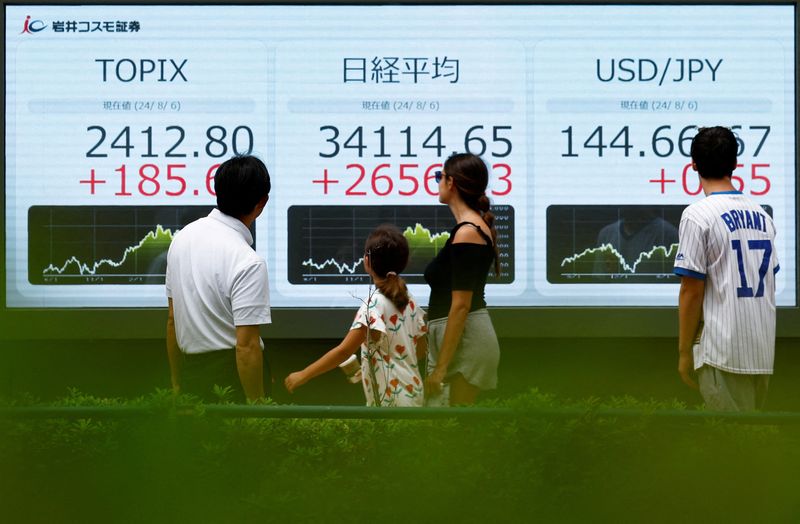By Vidya Ranganathan
SINGAPORE (Reuters) - Global stock and bond markets, in particular Japan's, are being rocked by an unwinding of the hugely popular yen carry trade.
That trade, which involves borrowing yen at a low cost to invest in other currencies and assets offering higher yields, is being wrecked by Japan's rate increases, a volatile yen and imminent rate cuts in the United States and other economies.
Here is a deeper look at the yen carry trade.
HOW DOES THE CARRY TRADE WORK?
It involves borrowing the yen, or any other currency with similar super-low interest rates, then using it to buy currencies with better yields.
The yen has been the funding currency of choice for carry trades in U.S. dollars, Mexican pesos, New Zealand dollars and some others.
The trade involves buying the higher-yielding currency with the borrowed yen to invest in bonds or other money market instruments in that currency.
At the end of a usually short-term trade, the investor converts the dollars or pesos back into yen, and repays the loan.
Annualised returns typically can be around 5% to 6% on dollar-yen carry trades, which is the difference between U.S. and Japanese rates, with a scope for more gains were the yen to depreciate during that term.
WHAT IS THE GENESIS OF THE YEN CARRY TRADE?
If defined broadly as using a low-yielding yen to buy higher-yielding foreign assets, then its origins can be traced back to 1999 when Japan struck policy rates down to zero after its asset price bubble burst.
The Japanese turned to international markets to get anything better than the zero yields at home, ploughing trillions of dollars into foreign markets and thus turning Japan into the world's biggest creditor nation.
The carry trade as we know today, which involves yen borrowing by largely international investors, kicked off in 2013 under Prime Minister Shinzo Abe's quantitative and qualitative easing that coincided with rising rates in the United States and a depreciating yen.
Those trades reached new, gargantuan proportions over the course of 2022 and 2023 as the Federal Reserve raised rates rapidly to rein in inflation even as the Bank of Japan (BOJ) kept its short term rates negative, and as the yen swooned.
HOW LARGE IS THE YEN CARRY TRADE?
No one is quite sure. Using the narrowest definition of a pure currency carry trade, analysts point to the $350 billion of short-term external loans by Japanese banks as one estimate of yen-funded trades in the world.
That number could be an exaggeration if some of those loans are commercial transactions between banks or loans to foreign businesses needing yen.
But it could be also understating the actual size of yen carry trades because there could be billions of yen the Japanese themselves have borrowed to invest in markets at home.
Actual positions could be amplified because of how hedge funds and computer-driven funds use leverage.
Add to that the massive investments Japanese pension funds, insurers and other investors have made abroad. Japan's foreign portfolio investments were 666.86 trillion yen ($4.54 trillion) at the end of March, Ministry of Finance data shows - more than half in interest rate-sensitive debt assets, albeit most of it long term.
WHY IS THE YEN CARRY TRADE UNRAVELLING?
To be sure, the BOJ has only started raising rates and its overnight rate is just at 0.25% while dollar rates are roughly 5.5%.
But carry trades are more sensitive to currency moves and rate expectations than the actual level of rates, analysts say.
The mere talk of further rate rises in Japan and Fed rate cuts by September has driven the yen up 13% in a month and narrowed the yield gap, completely wiping out the slim gains in pure yen-dollar carry trades.

And as the big leveraged investors cut their billions of loss-making yen carry positions, they are being forced to de-leverage and shed other stock and bond holdings.
($1 = 146.8600 yen)